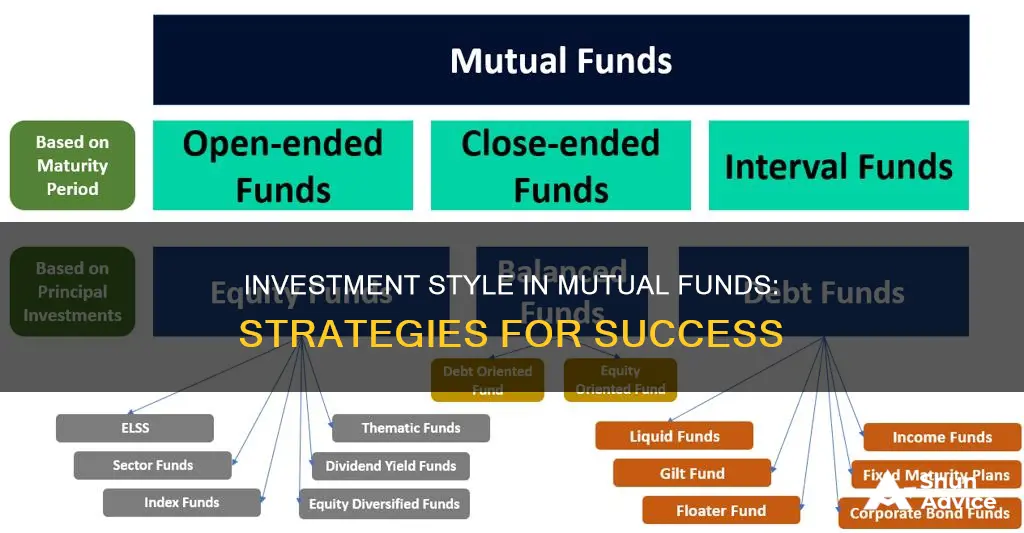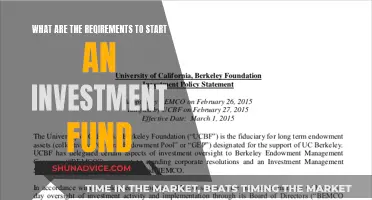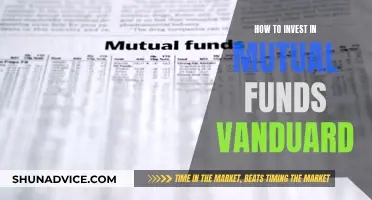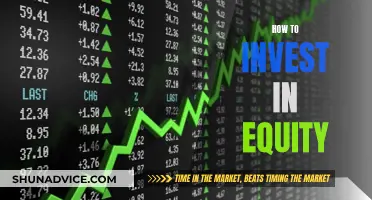
Investment style is a basic description of how a mutual fund invests, and it is an important signal for investors. It is based on several factors, including risk preference, growth vs. value orientation, and market cap. The investment style of a mutual fund helps set expectations for risk and performance potential. It is also used by institutional managers to market the fund to investors looking for a specific type of market exposure. A mutual fund's investment style can be visualized with a style box, popularized by Morningstar, which categorizes funds based on market capitalization and investment style. This tool is used by investors and advisors to compare and contrast different mutual funds.
| Characteristics | Values |
|---|---|
| Description | A basic description of how a fund invests |
| Stock investing objectives | Value or growth |
| Market capitalization | Large-cap, mid-cap, small-cap |
| Investment objectives | Growth, value, blend |
| Credit quality | High, medium, low |
| Maturity | Short-term, intermediate-term, long-term |
| Risk | Conservative, moderate, aggressive |
| Active vs passive management | Active, passive |
What You'll Learn

Risk tolerance
Investors typically begin their investment style choices by first assessing their risk tolerance, which can be classified as conservative, moderate, or aggressive. Conservative investors tend to favour income and fixed-income investments, such as money market funds, loan funds, and bond funds. These funds offer steady returns with lower risk. Moderate-risk investors, on the other hand, may be attracted to large-cap, blue-chip securities or value investment styles. These investments offer a balance between risk and return.
Aggressive investors, however, seek higher returns and are willing to take on more risk. They may opt for growth funds, aggressive growth funds, capital opportunity funds, or alternative hedge fund investment styles. These funds utilise leverage and derivatives to maximise returns. Additionally, aggressive investors may explore global securities or focus on high-growth regions like emerging markets.
The investment style of a mutual fund is crucial for setting expectations for both risk and performance potential. It helps investors make informed decisions by signalling the fund's risk profile and return potential. This information is vital for investors to determine if a particular fund aligns with their risk tolerance and investment goals.
Furthermore, the concept of risk tolerance is not limited to an investor's preferences. Investment style disclosures, such as prospectuses, also outline the levels of risk associated with a fund. These documents provide in-depth details on the fund's investment approach, allowing investors to assess whether the level of risk aligns with their tolerance and objectives.
Corporate Bond Funds: Smart, Secure Investment Strategy
You may want to see also

Growth vs value
Investment style is the method and philosophy followed by an investor or money manager when selecting investments for a portfolio. The investment style of a mutual fund helps set expectations for risk and performance potential, and it is an important aspect used by institutional managers in marketing and advertising the fund to investors looking for a specific type of market exposure.
Growth and value investing are two competing investment styles. Both can maximise value for investors, but they take different approaches.
Growth investors are attracted to companies that are expected to grow faster—either by revenues or cash flows, and definitely by profits—than the rest. As growth is the priority, companies reinvest earnings in themselves to expand. Growth companies offer higher upside potential and are therefore inherently riskier. There's no guarantee that a company's investments in growth will successfully lead to profit. Growth stocks experience stock price swings of a greater magnitude, so they may be best suited for risk-tolerant investors with a longer time horizon.
Value investing, on the other hand, is about finding companies whose stock prices don't necessarily reflect their fundamental worth. Value investors seek out businesses trading at a share price that is considered a bargain. Over time, the market will properly recognise the company's value and the price will rise. Value funds don't emphasise growth above all, so even if the stock doesn't appreciate, investors typically benefit from dividend payments. Value stocks have more limited upside potential and can, therefore, be safer investments than growth stocks.
Growth and value stocks can also be distinguished by their relative expense. Growth stocks are more "expensive", with high stock prices relative to their sales or profits. This is due to expectations from investors of higher sales or profits in the future, so expect high price-to-sales and price-to-earnings ratios. Value stocks are less "expensive", with stock prices that are low relative to their sales or profits. They have already proven their ability to generate profits based on a proven business model.
There are blended funds created by portfolio managers that invest in both growth and value stocks. Many managers of these blended funds pursue a strategy known as "growth at a reasonable price" (GARP), focusing on growth companies but with a keen awareness of traditional value indicators.
Best Mutual Funds to Invest in This Year
You may want to see also

Market capitalisation
Mutual funds can be categorised based on market cap, which indicates the size of the companies a fund invests in, not the size of the fund itself. These categories include small-cap, mid-cap, and large-cap funds. Small-cap funds typically include companies with market caps of less than $2 billion, while mid-cap funds invest in companies with market caps between $2 billion and $10 billion. Large-cap funds, on the other hand, comprise companies with market caps of $10 billion or more.
The choice between these categories is an important aspect of investment style, as it determines the level of risk an investor is willing to take. Small-cap funds, for example, can be volatile and generate sharply negative returns in times of market instability. On the other hand, they offer great opportunities for aggressive growth. Mid-cap funds, while theoretically less risky than small-cap funds, may still be vulnerable to violent swings in the market. Large-cap funds, meanwhile, tend to offer steadier returns and are a good choice for investors with long-term holding periods who want to assume less risk.
Market cap is also used to compare a company's financial performance to other companies of various sizes. It is often used as a baseline for analysis, as all other financial metrics must be viewed in relation to this figure. For example, a company with a high market cap may be considered underperforming if its revenue is only twice that of a company with a much smaller market cap.
In summary, market capitalisation is a key factor in determining investment style, as it indicates an investor's risk tolerance and return expectations. It is also a valuable tool for comparing companies of different sizes and assessing their financial performance.
Conservative Mutual Funds: Maximizing Returns, Minimizing Risk
You may want to see also

Active vs passive management
When it comes to investing in mutual funds, there are two main approaches: active management and passive management. These terms refer to the level of involvement and decision-making that fund managers have in the investment process. Here's a detailed look at the differences between these two investment styles:
Active Management
Active management involves fund managers taking a hands-on approach to investing. These managers actively research, analyse, and select specific investments for the fund's portfolio. They aim to beat the market averages and generate higher returns by buying and selling investments based on their short-term performance and future expectations. Active management requires a deep analysis of qualitative and quantitative factors, allowing fund managers to pivot in and out of particular stocks, bonds, or assets. This approach provides flexibility, as active managers can invest in "diamond in the rough" stocks and are not restricted to a specific index. It also offers hedging opportunities and the ability to manage risk by exiting specific holdings when risks become too high. Additionally, active management allows for tax management strategies tailored to individual investors.
However, active management comes with higher costs. The extensive research, analysis, and frequent trading incur significant transaction costs, and the salaries of the analyst team are covered by investors. These higher fees can eat into investment returns over time. Another disadvantage is the management risk—even the most experienced fund managers can make costly mistakes.
Passive Management
Passive management, on the other hand, involves fund managers taking a more passive role. Instead of actively selecting individual investments, passive managers aim to replicate the performance of a specific market index, such as the S&P 500 or the Dow Jones Industrial Average. Passive funds buy and hold a basket of stocks that mirror the composition of the chosen index. This approach is often associated with mutual funds and exchange-traded funds (ETFs). Passive investing is a long-term strategy that disregards short-term market fluctuations. It is a more cost-effective approach, as passive funds have lower expense ratios due to their mechanical buying and selling based on the index they track. Passive investing also offers transparency, as investors always know what stocks or bonds are included in the fund. Additionally, the buy-and-hold strategy typically results in lower capital gains taxes.
However, passive investing has its limitations. Passive funds are restricted to a specific index or predetermined set of investments, providing less flexibility. They rarely beat the market, as their core holdings are designed to track the market's performance. Additionally, passive investors rely on fund managers to make decisions, which may not align with their specific investment preferences.
Both active and passive management styles have their advantages and disadvantages. Active management offers more flexibility and the potential for higher returns but comes with higher costs and the risk of underperforming the market. On the other hand, passive management provides cost-effectiveness, transparency, and tax efficiency but may limit investment opportunities and returns. Ultimately, the choice between active and passive management depends on an investor's risk tolerance, investment goals, time horizon, and personal preferences. Many investors and advisors blend these strategies to diversify their portfolios and manage risk effectively.
Index Funds: Long-Term Risks and Rewards
You may want to see also

Investment objectives
The investment objectives of stock funds can be categorised into three main types: growth, value, or blend. Each of these types of funds has distinct characteristics and is suited to different investor profiles.
Growth stock funds invest in stocks of companies that are expected to grow at rates faster than the market average. These stocks are not cheap and are available at a price higher than their intrinsic values. They are considered to have the potential to outperform the overall market over time because of their future potential.
Value stock funds, on the other hand, invest in stocks that are predicted to be selling at prices lower than their market value. These stocks are available at a price lower than their intrinsic values but have the potential to unlock values in the long run. Value stock funds are also called "dividend mutual funds" because they often pay dividends to investors.
Finally, blend stock funds, as the name suggests, invest in a blend of growth and value stocks. This style of investing intermingles growth and value styles.
It is important to note that the decision to invest in growth versus value stocks is ultimately dictated by an individual investor's preference, risk tolerance, investment goals, and time horizon.
In addition to these stock fund investment objectives, mutual funds can also be classified by their market capitalization, which measures the size of a business and is expressed as a figure of the single-share price times the number of outstanding shares. Large-cap stock funds invest in stocks of large corporations, most often with a market capitalization of over $10 billion. Mid-cap stock funds focus on corporations with a mid-size capitalization, usually between $2 billion and $10 billion, while small-cap stock funds target companies with a lower capitalization, typically between $500 million and $2 billion.
When choosing a mutual fund, it is crucial to consider your investment goals and comfort with risk. Different funds have different risk profiles, and it is essential to understand these characteristics before investing.
Invest Your Provident Fund: A Guide to Getting Started
You may want to see also
Frequently asked questions
An investment style is the method and philosophy followed by an investor or money manager when selecting investments for a portfolio.
A mutual fund style is a basic description of how a fund invests. It can refer to a few core traits, including the stock investing objectives of value or growth, as well as the average market capitalization of the fund's portfolio holdings.
The investment style of a mutual fund helps set expectations for risk and performance potential. It is also an important aspect used by institutional managers in marketing and advertising the fund to investors looking for a specific type of market exposure.







